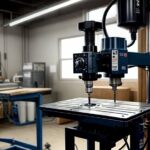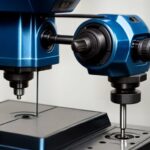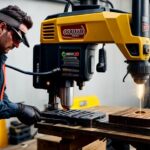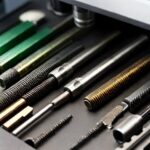As an avid woodworker, you’ve undoubtedly been frustrated by a workpiece sliding or shifting while drilling. Now put on your safety goggles and begin clamping! Drill press table clamps come in handy here!
These unsung workshop heroes boost safety and the precision and efficiency of your drilling efforts. If you want to improve your woodworking skills and optimize your workflow, this complete guide to drill press table clamps is for you.
We’ll go deep into clamps, investigating the wide varieties available, how to choose the best one for your requirements, and giving top recommendations for increasing their efficacy.
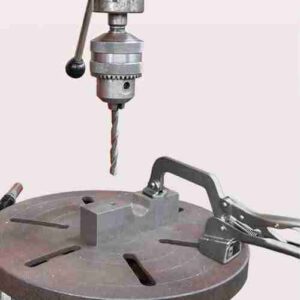 Importance of Drill Press Table Clamps:
Importance of Drill Press Table Clamps:
- Increasing drilling safety – Drill press table clamps securely lock your workpiece to the table, preventing it from shifting or sliding as you drill. This reduces the possibility of accidents and injuries caused by a loose or unsteady workpiece.
- Increasing precision and accuracy – When your workpiece is firmly secured in place, it is simpler to maintain constant alignment and placement throughout the drilling operation. This guarantees that your holes are drilled precisely where you need them, reducing the possibility of mistakes that might jeopardize the overall quality of your project.
- Improving job efficiency – In a busy workplace, time is money. You’ll spend less time relocating and modifying your project if you use drill press table clamps to keep it steady, enabling you to work more effectively and finish chores quicker.
- Workpiece protection – Clamps may assist in avoiding damage to your workpiece while drilling. Keeping it safe and stable may prevent issues like tear-out, splintering, and cracking, ensuring that your project is in great shape from start to end.
Types of Drill Press Table Clamps:
1. C-clamps: Design and description:
C-clamps, or G-clamps, are distinguished by a C-shaped body with a threaded screw extending from one end. The clamp may be tightened or loosened by rotating the screw to secure a workpiece on the drill press table.
C-clamps are multifunctional, simple to locate, and reasonably priced. They may be utilized for various tasks other than drill press labor.
Cons:
Setting the clamp takes time, and the clamping pressure may be uneven compared to other clamp types. The clamp body may also obstruct your workstation.
2. Quick-release clamps:
These clamps feature a movable jaw that may be changed rapidly by pushing a trigger or lever. The jaw is then secured to provide a firm grip on the workpiece.
Quick-release clamps are simple to use and offer quick, effective clamping. They are particularly beneficial for repeated jobs or when you need to adjust your workpiece regularly.
Cons:
They may have less clamping power than others, and certain versions may be more costly.
3. Hold-down clamps:
Hold-down clamps feature a T-shaped body that fits into the drill press table’s T-slot or T-track. They secure the workpiece in position by applying downward pressure with a long screw or lever.
Pros:
Hold-down clamps provide high gripping power and are developed primarily for use with drill press tables. They keep the workplace free and do not block it.
Cons:
They need a drill press table with a corresponding T-slot or T-track, and they may need to be more adaptable for other applications.
4. Toggle clamps:
Toggle clamps apply clamping pressure through a pivot mechanism using a lever or grip. As you move the handle, the clamp’s jaws open and shut, delivering rapid and secure clamping.
Toggle clamps provide quick, effective clamping and release. They are simple to use and give a firm grip on the workpiece.
Cons:
Custom installation on the drill press table may be required, and certain versions may have restricted clamping capability.
5. T-track clamps
T-track clamps are used with T-slot or T-track systems. They slide into the track, positioning the clamp anywhere along the slot for flexible and secure clamping.
Pros:
T-track clamps are versatile, allowing you to move the clamp to accommodate various workpieces. They keep the work area accessible and provide a firm grip.
Cons:
They need a drill press table with a corresponding T-slot or T-track and may not be as helpful for non-drill press applications.
How to Choose the Right Drill Press Table Clamp?
- Evaluating your needs and job requirements: Consider the tasks you generally work on, the resources you employ, and the degree of accuracy necessary. This will assist you in determining which clamp characteristics are most relevant to your particular requirements.
- Drill press table compatibility: Be sure the clamp you purchase is compatible with your drill press table, particularly if it requires a T-slot or T-track. Verify the dimensions and specs of your table to guarantee a suitable fit.
- Material and construction quality: To guarantee durability and dependable performance, choose clamps built of sturdy materials such as heavy-duty steel or cast iron. High-quality clamps will give more clamping power and stability, resulting in more precise and secure drilling.
- Clamp capacity and size: Assess the size and thickness of the workpieces you frequently deal with, and choose a clamp with the right capacity and size. If your clamp is too tiny or too big for your workpiece, it may not offer enough clamping force or stability.
- Adjustability and simplicity of use: Look for clamps that are simple to adjust, with features such as quick-release mechanisms or smooth-sliding components. Simple-to-use and adjusted clamps will save you time and stress, enabling you to concentrate on your task.
- Financial considerations: Establish a budget for your clamp purchase and assess the advantages and disadvantages of each clamp type. Although it is crucial to invest in high-quality equipment, there are often low-cost alternatives that may provide outstanding results. Remember that investing a little extra in a high-quality clamp can save you money in the long term by minimizing damage to your workpieces and decreasing the need for repairs or replacements.
Tips:
- Alignment and positioning: Before fastening your workpiece, ensure it is correctly aligned with the drill bit and positioned on the bench. This will assist in guaranteeing precise drilling and protect your workpiece from harm.
- Tight but not too tight: Use the clamp firmly to secure your workpiece, but avoid over-tightening, which may cause damage or warping. Ensure there is enough clamping force to prevent movement during drilling but not so much that the material is deformed or marred.
- Employ the appropriate clamp for the job: Adapt the clamp type and size to your project’s needs. Use a hold-down clamp, for example, to drill thin materials or a C-clamp to secure bigger workpieces.
- Maintain a clean work area: Ensure the clamp body or components do not restrict your workspace or interfere with drill press operation. This will assist in keeping the workplace safe and efficient.
- Inspect and maintain your clamps regularly for wear, damage, or corrosion indications, and clean them as required. Correctly maintaining your clamps can extend their life and guarantee consistent functioning.
- Mix clamp kinds: Combine clamp types to secure your workpiece for the best results. This may improve stability and accuracy, particularly for complicated jobs.
- Be patient: While putting up and adjusting clamps, take your time since hurrying might lead to errors or damage. More care and attention throughout the clamping process may significantly increase the quality and accuracy of your drilling efforts.
Frequently Asked Questions (FAQs)
1. Can I use any type of clamp with my drill press table?
Not all clamps are compatible with every drill press table. It is essential to check the specifications of your drill press table and ensure the clamp you choose fits and works well with your table. Some clamps require T-slots or T-tracks, so make sure your table has the necessary features for the clamp you want to use.
2. How do I know what size clamp I need for my workpiece?
To determine the appropriate clamp size for your workpiece, consider the thickness and overall dimensions of the material you typically work with. Choose a clamp with a capacity and size that can accommodate your workpiece without causing damage or instability during the drilling process.
3. What is the difference between a hold-down clamp and a C-clamp?
A hold-down clamp is designed specifically for drill press tables and provides strong downward pressure to secure the workpiece. These clamps require a T-slot or T-track on the table. A C-clamp, also known as a G-clamp, has a C-shaped body with a threaded screw for tightening and is a more versatile clamp that can be used for various applications, not just drill press work.
4. How often should I inspect and maintain my clamps?
Inspect your clamps regularly for signs of wear, damage, or corrosion. Clean them as needed and perform maintenance tasks, such as lubricating moving parts, to ensure smooth operation and prolong their lifespan. Regular maintenance will help prevent clamp failure and ensure consistent performance.
5. Can I use multiple clamps on one workpiece?
Yes, using multiple clamps on a single workpiece can improve stability and accuracy, especially for complex projects. Combining different types of clamps can provide better support and prevent movement during the drilling process.
6. What should I consider when setting a budget for purchasing clamps?
Set a budget based on your needs and priorities, and weigh the pros and cons of each clamp type. While it’s essential to invest in high-quality tools, there are often more affordable options that can still deliver excellent results. Keep in mind that investing a little extra in a high-quality clamp can save you money in the long run by reducing workpiece damage and the need for repairs or replacements.
Last words:
Drill press table clamps are required for precise and safe drilling outcomes. Consider the sort of tasks you’ll be working on, compatibility with your drill press table, material and construction quality, clamp capacity and size, simplicity of use, and flexibility when selecting the proper clamp.
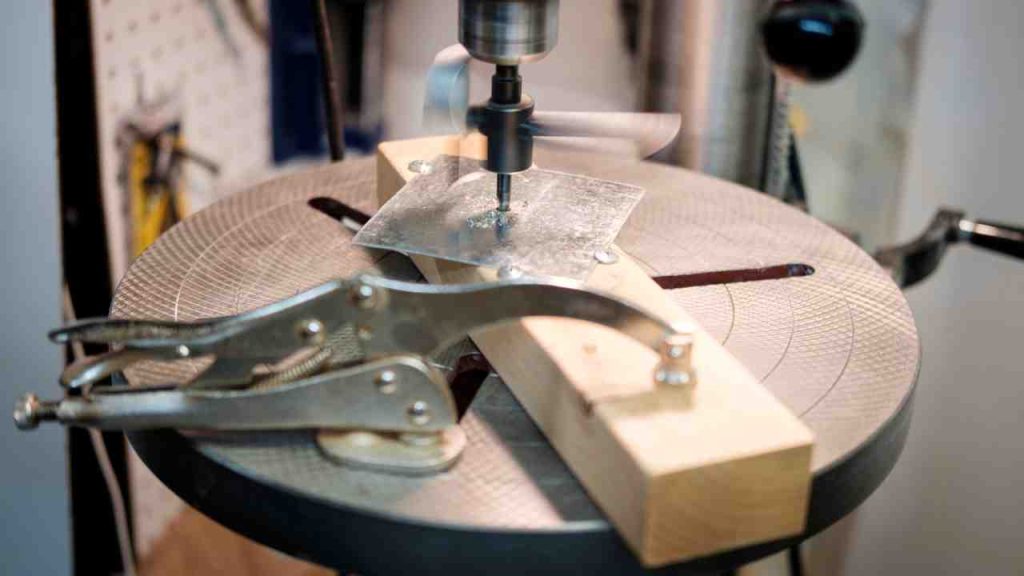
Use clamps efficiently by accurately aligning the workpiece, applying the appropriate amount of clamping pressure, keeping the workspace clean, and maintaining your clamps. You can improve your drilling game and obtain accurate, safe, and efficient results with high-quality clamps and the right technique, whether you’re a professional carpenter or a DIY enthusiast.
- Where are WEN drill presses made? - April 2, 2023
- Where are Rikon drill presses made? - April 1, 2023
- Where are Powermatic drill presses made? - April 1, 2023


